7 Best video editing APIs - 2025

If you're searching for the best video editing APIs in 2025, chances are you’re:
- Building a product that needs automated video generation
- Trying to scale creative production
- Or just tired of exporting the same thing a hundred times
The problem is, not all APIs are built the same. Some are easy to get started with. Some give you precise AE-level control. And some feel like you need a PhD to deploy them.
We’ve been in the video industry long enough to know: the right API can make or break your workflow.
That’s why we analyzed 7 top video editing tools, based on real use cases, API complexity, pricing structure, and actual capabilities, so you don’t have to spend hours digging through docs or sales decks.
Here’s everything we found, so you can choose the best video editing API for your workflow.
Plainly Videos
It’s not just that Plainly is our own tool; it’s that it genuinely is one of the best, if not the best, cloud video editing API for teams who care about both scale and creative control.
Plainly lets you render dynamic videos from Adobe After Effects templates, powered by your own data. Unlike platforms locked into visual builders or limited animation options, Plainly runs your AE project in the cloud, where it handles the rendering and delivery. And whether you're using the web app or the API, everything you can do in one, you can do in the other.
We’ve built it for developers, motion designers, marketers, and ops teams who want to automate professional video content creation, but still want it to look like it was handcrafted.
Pros
- Lets you use actual After Effects templates
- Designed for high-scale cloud rendering
- Works well with dynamic data (text, images, video, audio)
- Solid support + API documentation
- 20+ integrations
- Enterprise security / ISO 27001 and GDPR certified
Cons
- Not a full editing suite (you create your base video templates in AE)
- Has a learning curve if you're unfamiliar with AE or dynamic video concepts
Pricing
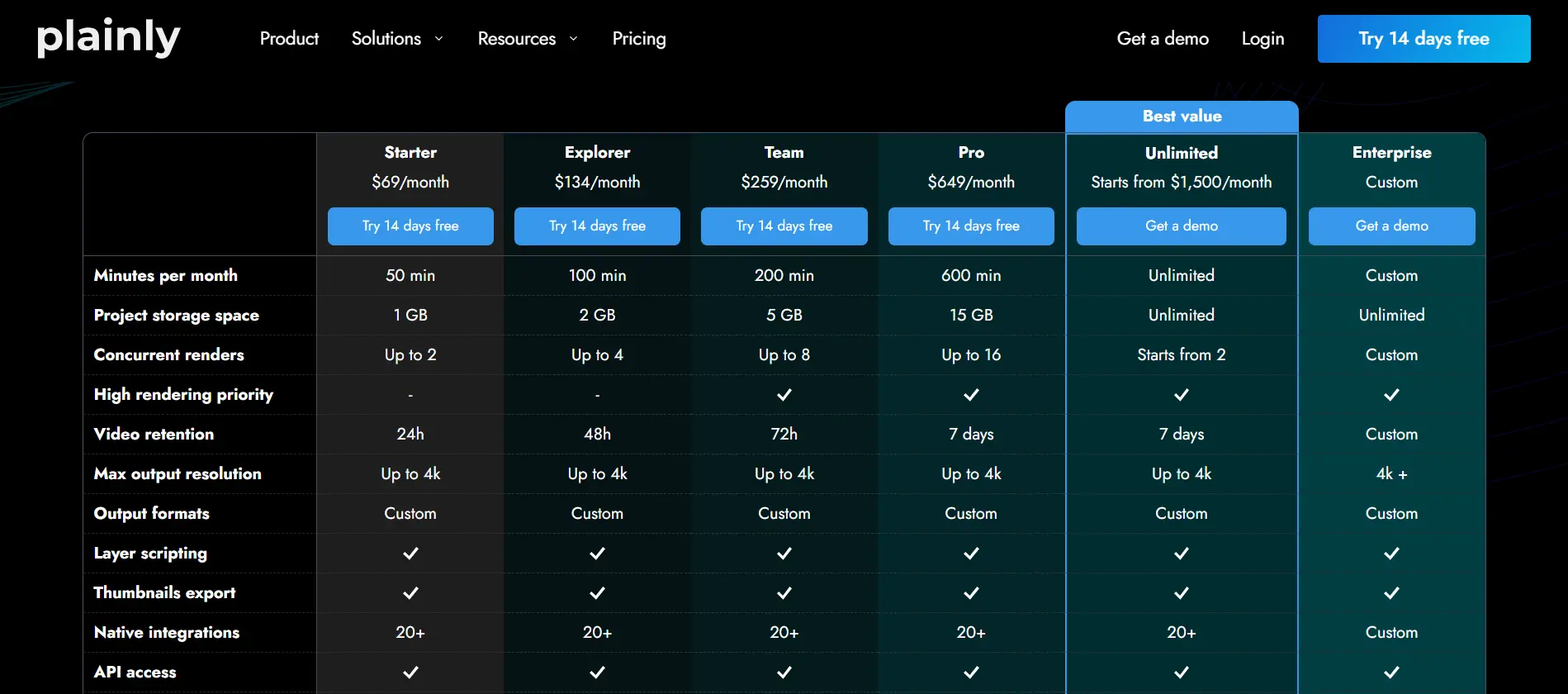
Plainly’s pricing is based on the number of render minutes you use monthly.
The Starter plan starts at $69/month, which includes enough render minutes (50) for small-to-mid-scale use.
You can scale up to higher tiers as your rendering needs grow - including Explorer at $134/month for 100 minutes, Team at $259/month for 200 minutes, and Pro at $649/month for 600 minutes. Or opt for the Unlimited plan at $1,500/month, which gives you unlimited rendering and storage.
Custom plans are also available for Enterprises.
We suggest the Starter plan if you’re just starting out. But for teams running high-volume, personalized campaigns, Unlimited is a no-brainer.
Shotstack
If you’re a developer building a custom video pipeline, we recommend starting your search with Shotstack.
That’s because Shotstack is a cloud-based video editing API designed for developer-first teams that need to automate video production. It’s built around a JSON editing structure, which means that using the Shotstack video editing API, you can programmatically control timeline, clips, overlays, audio, transitions, and more.
Instead of relying solely on a visual video editor or an After Effects base, Shotstack lets you construct entire video timelines using code, though it also offers a basic online video editor for simpler projects. That gives you precise control if you're coding, but thanks to their Canva-style web-based editor, even marketers or non-technical users can get started without deep video editing experience.
You can also rely on their generative AI to generate scenes, images, or audio assets for videos using text prompts, which comes in handy if you need to quickly spin up creative variations.
Pros
- Full control over the video timeline through JSON
- Good documentation & SDKs for major languages
- Built-in hosting & rendering
- Customizable white-label video editing
Cons
- Limited visual editor - best for simple projects
- Advanced animation or After Effects-level control isn’t supported
- Timeline logic can get complex fast
- Source file size limits apply (max 5GB)
Pricing
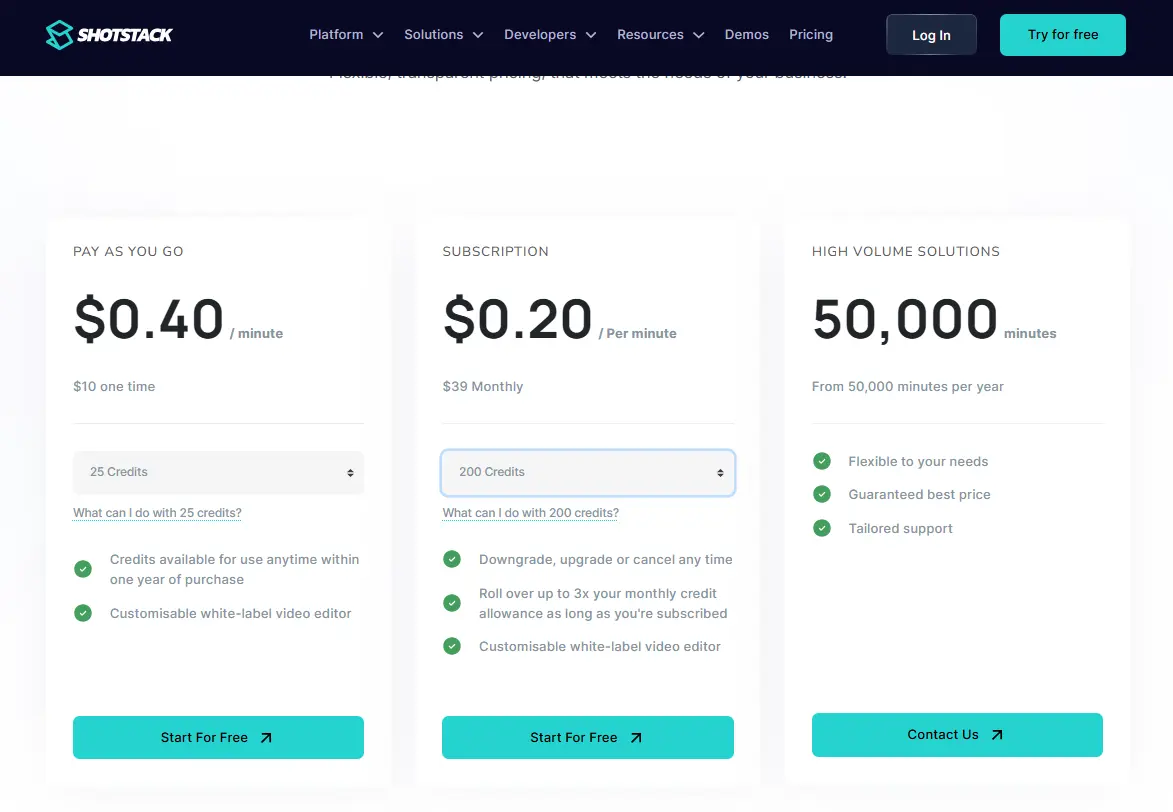
Shotstack uses credit-based pricing tied to video duration (per rendered minute). You can pay as you go at a starting rate of $0.40 per minute, though bear in mind that the minimum you can purchase is 25 credits.
To paint a picture, with these 25 credits, you can either:
- Render 25 videos, each 1 minute in length
- Generate 16.667 AI-powered videos
If you’d rather subscribe, you’ll get a more favorable, $0.20 per minute starting rate, which gets lower the more monthly credits you need.
And if your needs go beyond the 50,000-minute mark, we suggest you opt for their High volume solution. Though you’ll need to contact their team for a quote.
Bannerbear
Bannerbear started as an API for dynamic image generation, but later added video capabilities, thus allowing you to generate short, branded videos from templates with dynamic text, images, or audio.
We find it especially useful for social media video automation, product videos, or auto-generating marketing assets. The platform leans more toward template-based video generation, making it great for fast deployment. However, it's limited if you need fine control over animation timing or transitions, in which case some other Bannerbear alternatives might suit you better.
Pros
- Easy to get started, even without dev experience
- Clean UI and visual template builder
- Supports image and video generation via API
- Includes integrations (Zapier, Airtable, Make)
Cons
- Limited animation/timeline complexity
- Creative flexibility is capped by the template system
- Max video duration: 5 minutes
- Overlay-heavy videos can consume credits fast
Pricing
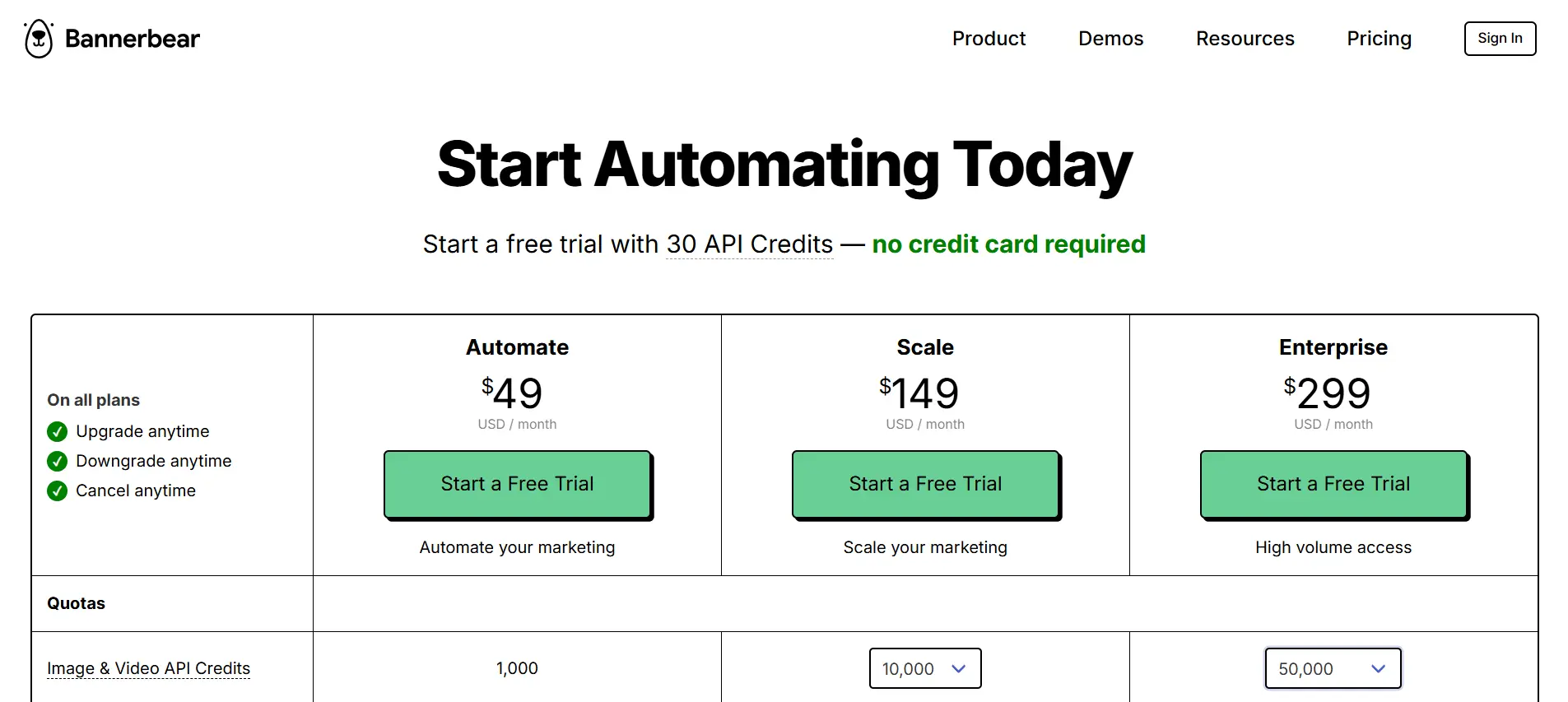
Pricing is based on API credits, where each 5 seconds of video processing costs 1 credit, with an added 1 credit per overlay frame.
That means a 10-second video with 1 overlay frame would cost 10 credits (2 + 1 = 3).
That said, Bannerbear has 3 plans in total, which give you a different number of credits, including:
- Automate: $49/month, 1,000 credits
- Scale: Starts from $149/month, 10,000 credits
- Enterprise: Starts from $299/month, 50,000 credits
Creatomate
Want to create and automate? That’s exactly what Creatomate was built for.
True to its name, Creatomate (Create + Automate) is a video generation API designed for automating templated content, especially for marketing, social media, and product video workflows.
The platform comes with its own visual editor, where you build templates directly inside. From there, you can create and edit videos, and also automate rendering via the API using dynamic inputs like text, images, or URLs.
Pros
- In-browser template builder, no AE needed
- Developer-friendly API with SDKs (Node.js, PHP, etc.)
- Supports text/image/video/audio input
- Built-in hosting & delivery features
Cons
- Templates are locked to the native editor
- Editing features are limited, meaning a more advanced Creatomate alternative like Plainly or Shotstack could be a better option
- Scaling still requires developer setup
Pricing
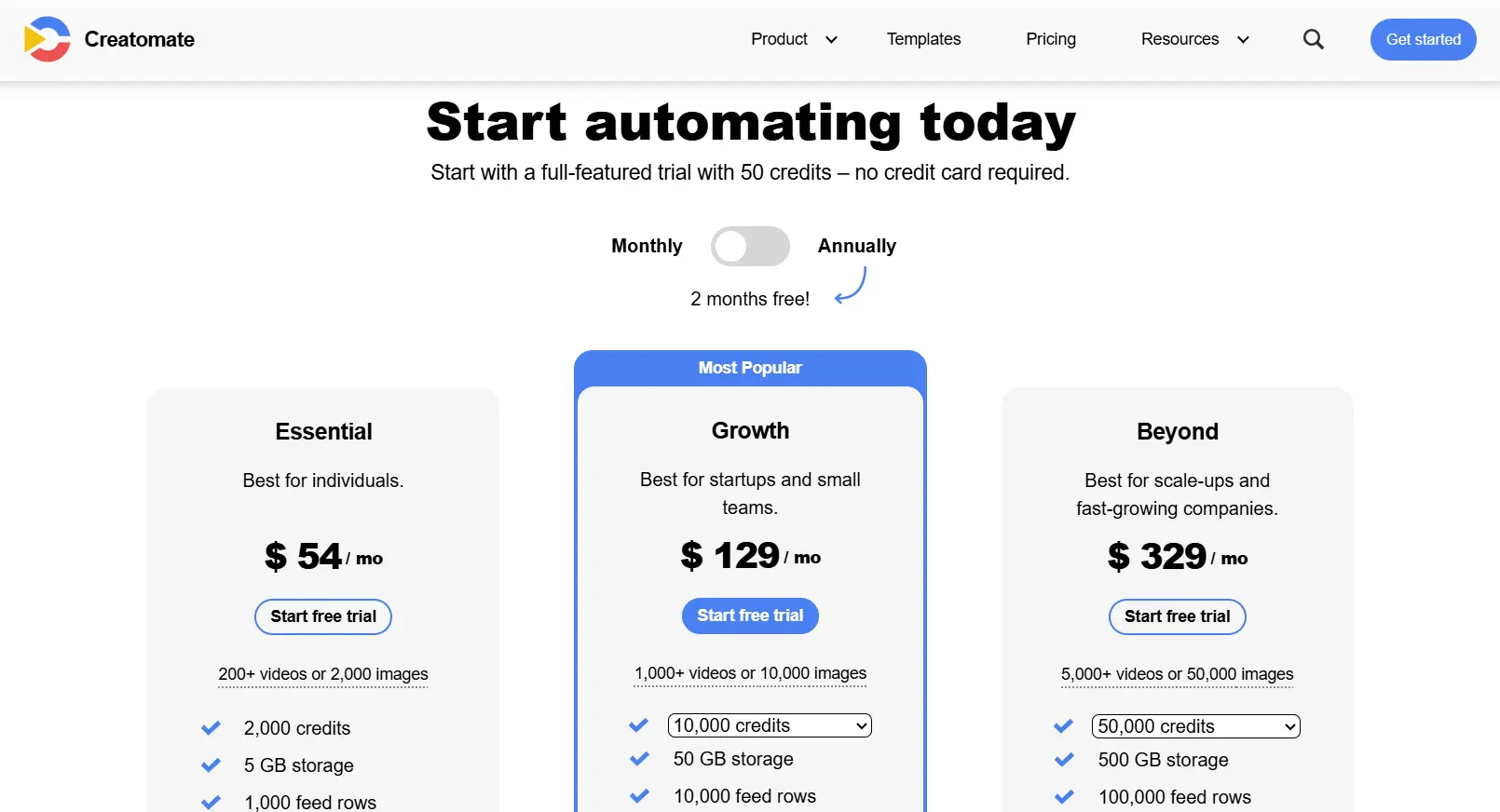
Similar to the majority of the best video editing APIs, Creatomate’s pricing is credit-based.
That said, plans scale depending on how many credits you need:
- Essential - $54/month for 2,000 credits (roughly 200 short, 15-second videos at 720p)
- Growth - $129/month for 10,000 credits (roughly 1,000 short, 15-second videos at 720p)
- Beyond - $329/month for 50,000 credits (roughly 5,000 short, 15-second videos at 720p)
Placid
Placid is a no-code-friendly API that started with image generation but later expanded into video, similarly to Bannerbear. It’s mostly used for automating branded visuals, such as dynamic social posts, product videos, and similar assets.
The platform focuses on template-based rendering, and you can build those templates directly inside the Placid Studio. Then, using their API, you can populate those templates with custom data to create video (or image) assets automatically.
If you ask us, that makes Placid a solid pick if your use case revolves around video marketing automation, especially for content that needs to stay on-brand but vary across posts, products, or users.
Pros
- Great for automating social video content
- Comes with a template editor + API access
- Also supports image generation
- Good customer support
Cons
- Less flexibility for complex video workflows
- Video rendering is slower for longer formats
Pricing
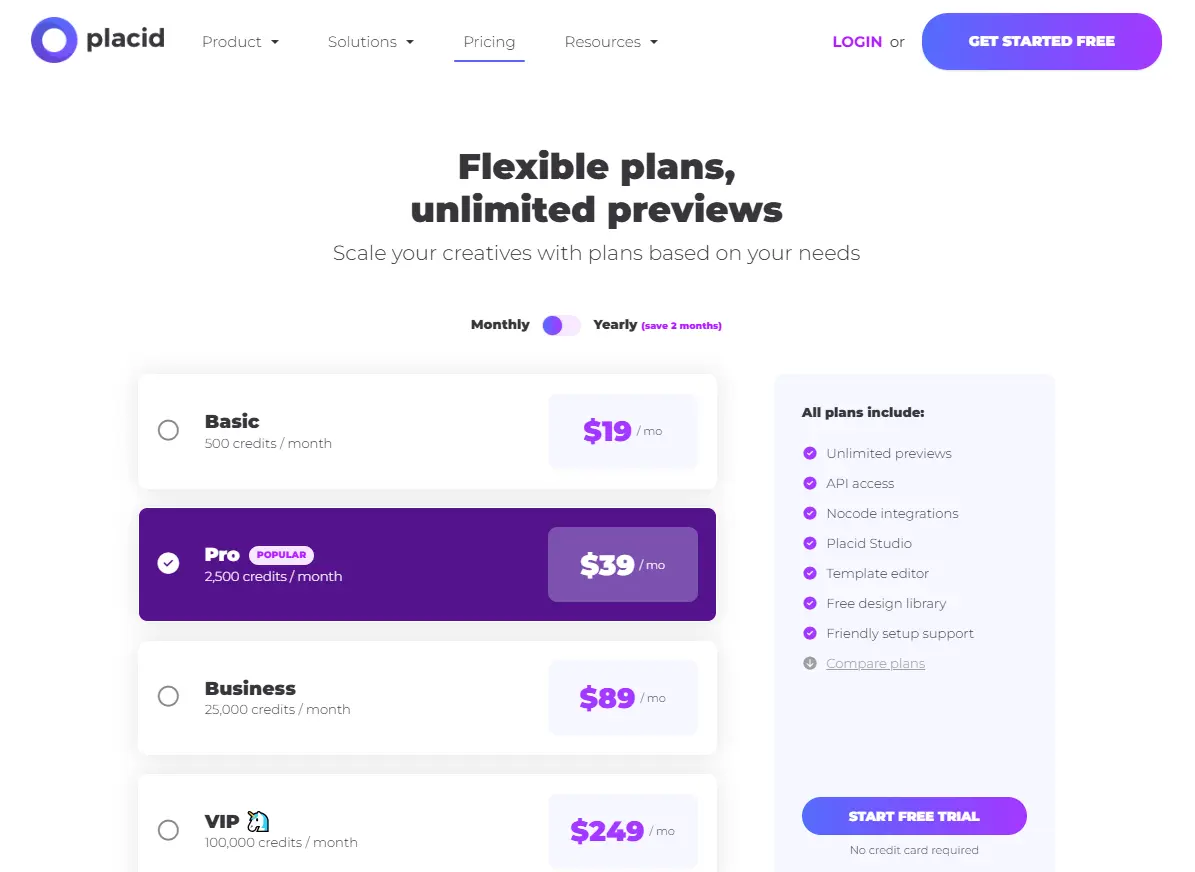
There are a total of 4 pricing tiers, closely tied to the number of monthly generation credits:
- Basic - $19/month, 500 credits
- Pro - $39/month, 2,500 credits
- Business - $89/month, 25,000 credits
- VIP - $249/month, 100,000 credits
As mentioned, you can also use Placid’s API to generate images, but when it comes to video creation, 1 credit equals 1 second of video.
JSON2Video
JSON2Video is a simple but flexible video editing API made for scaling video content automation. It’s built around a clean JSON structure where you define scenes, text, images, audio, and transitions.
You can use it to generate videos directly from code, or plug it into Make.com for no-code, fully automated workflows. It supports subtitles, voiceovers, and basic animation, which is enough to cover most structured content use cases. It’s not made for heavy motion design, but if you need to create a lot of straightforward videos from data, it gets the job done without much setup.
Pros
- Easy-to-use JSON schema
- Supports Make.com and other no-code tools
- Voiceovers, subtitles, and simple animation included
- Great for product, real estate, or content automation
Cons
- Not ideal for complex motion graphics or visual effects
- Mostly code-based
- Fewer customization options than high-end tools
Pricing
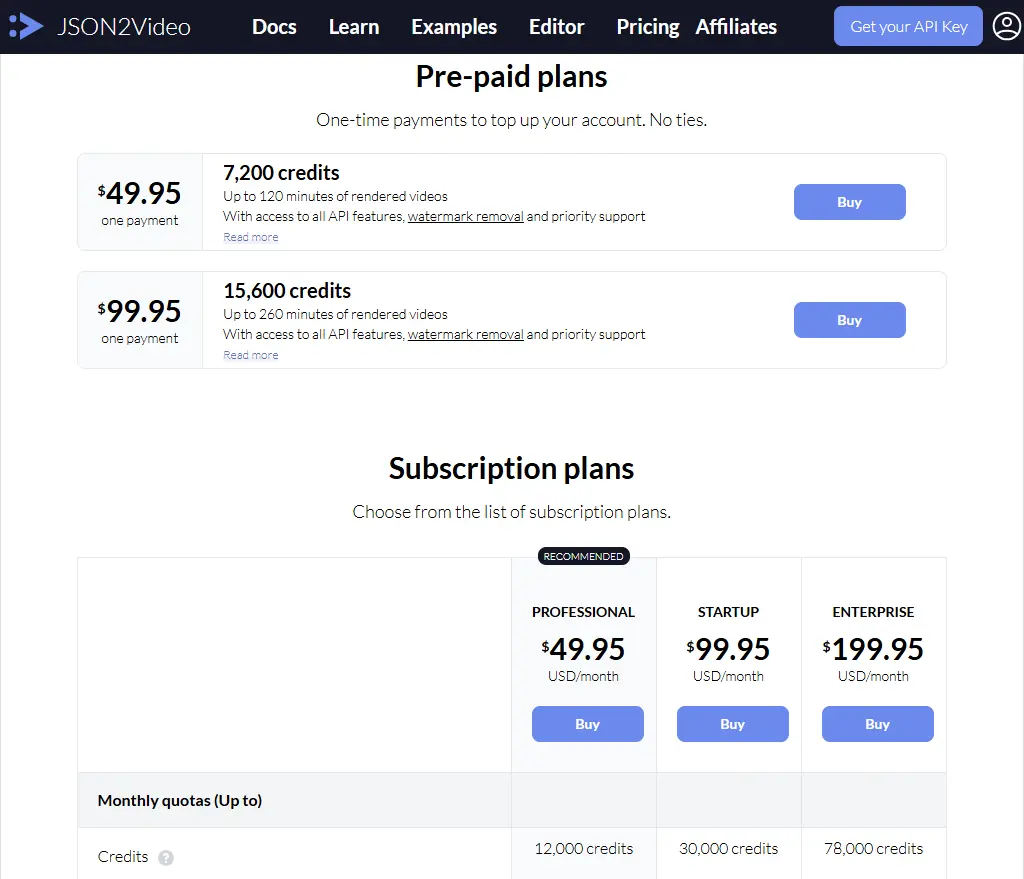
JSON2Video’s plans are based on how many minutes of video you render.
They offer a free plan that lets you test the API with up to 600 seconds (10 minutes) of video.
As for paid plans, you can opt for pre-paid credits or monthly subscriptions.
Pre-paid plans are one-time payments where you top up your account with credits and use them at your own pace. To put in perspective:
- $49.95 gets you 7,200 credits (about 120 minutes of video)
- $99.95 gets you 15,600 credits (about 260 minutes of video)
However, if you’re running projects regularly, we recommend subscribing simply because the plans offer better value and come with premium support. You can choose from:
- Professional - $49.95/month: 12,000 credits (200 minutes), max video length 10 min
- Startup - $99.95/month: 30,000 credits (500 minutes), max video length 30 min
- Enterprise - $199.95/month: 78,000 credits (1,300 minutes), max video length 30 min
Abyssale
Abyssale is a creative automation platform that lets you generate videos, GIFs, images, PDFs, and HTML5 banners at scale using templates and an API.
It comes in handy when you need to build a high volume of branded content (e.g., social creatives, banners, product visuals, etc.) across multiple formats, without doing everything manually.
The platform comes with its own visual editor, and once you’ve set up templates, you can use the video editing API to populate and render them automatically. That makes it a flexible choice for marketing teams, though we find it to be less suited for precision animation workflows.
Pros
- Supports static images, video, GIFs, HTML5, and PDF generation
- Comes with a drag-and-drop editor and template-to-API workflow
- Offers async & batch generation for high-volume use
Cons
- Not meant for complex animations
- Video rendering is available only on Pro plans and above
- Long videos can consume credits quickly
Pricing
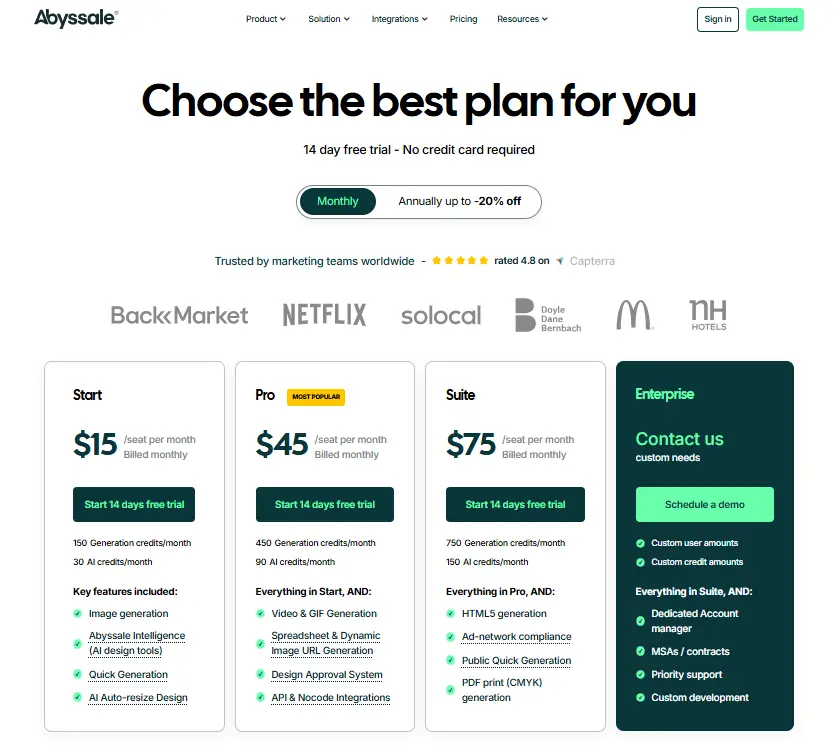
There are 4 plans in total, each priced per seat and tied to monthly generation credits:
- Start - $15/month per seat, includes 150 generation credits
- Pro - $45/month per seat, includes 450 generation credits
- Suite - $75/month per seat, includes 750 generation credits
- Enterprise - Custom pricing, based on usage and team size
As for how credits work, video, GIFs, and HTML5 animations consume 1 credit per second of generated content.
Quick comparison table of the best video editing APIs
We built this table to give you a no-fluff overview of what each video editing API does best - including pricing, complexity, and use cases.
Ready to scale? Choose the best video editing API for your use case
And there you have it – the best video editing APIs for every need.
It doesn’t matter if you're building from scratch, scaling marketing assets, trying to save time on repetitive exports, or doing something else entirely - there’s a tool in this list for you.
But if your goal is high-volume video generation AND full creative control with After Effects templates… why not go with the one built exactly for that - Plainly?
Book a demo with Plainly today & start automating content creation on your own terms!





